To support deaf participants during group video calls, guarantee clear visual access by positioning cameras properly, maintaining good lighting, and framing the camera at eye level. Speak clearly and use visual cues, gestures, and facial expressions. Enable captions and share transcripts promptly. Respect sign language interpreters by giving them space and not talking over them. Patience with response times and connection delays helps everyone stay engaged. Continue exploring to discover more ways to create an inclusive environment.
Key Takeaways
- Ensure sign language interpreters have clear visibility and sufficient space on screen.
- Use proper lighting and camera framing to support sign language understanding and lip-reading.
- Enable real-time captions and share transcripts promptly for inclusive communication.
- Maintain patience with response delays and connection issues, signaling turns visually when possible.
- Foster respectful interaction by acknowledging interpreters and avoiding speaking over them.
Ensure Clear Visual Access for Sign Language
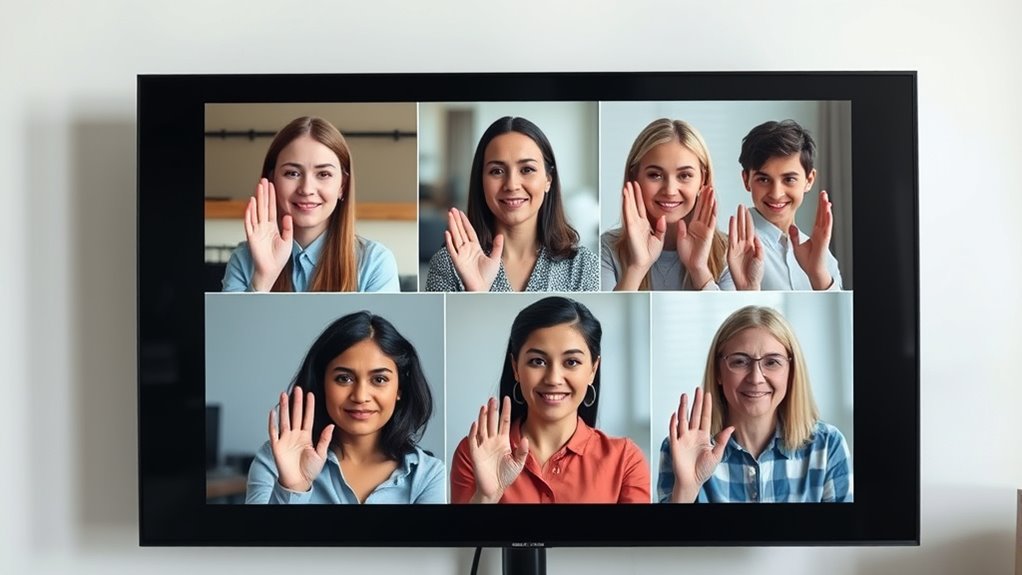
To support deaf participants effectively, you need to guarantee they have a clear view of sign language communication. Ensuring good visual access starts with positioning cameras so signers are fully visible. Encourage participants to speak directly to the signer, maintaining eye contact and avoiding obstructions. If someone has limited sign language proficiency, consider using visual access technology like high-quality video streams or dedicated sign language interpreters on-screen. This technology helps bridge communication gaps and keeps sign language clear and accessible. Keep the camera steady and at eye level to prevent distortion or missed signs. By prioritizing visual access, you create a more inclusive environment that respects deaf participants’ communication needs and promotes active engagement throughout the call. Recognizing the importance of visual communication can significantly enhance understanding and participation for deaf individuals.
Use Proper Lighting to Enhance Visibility
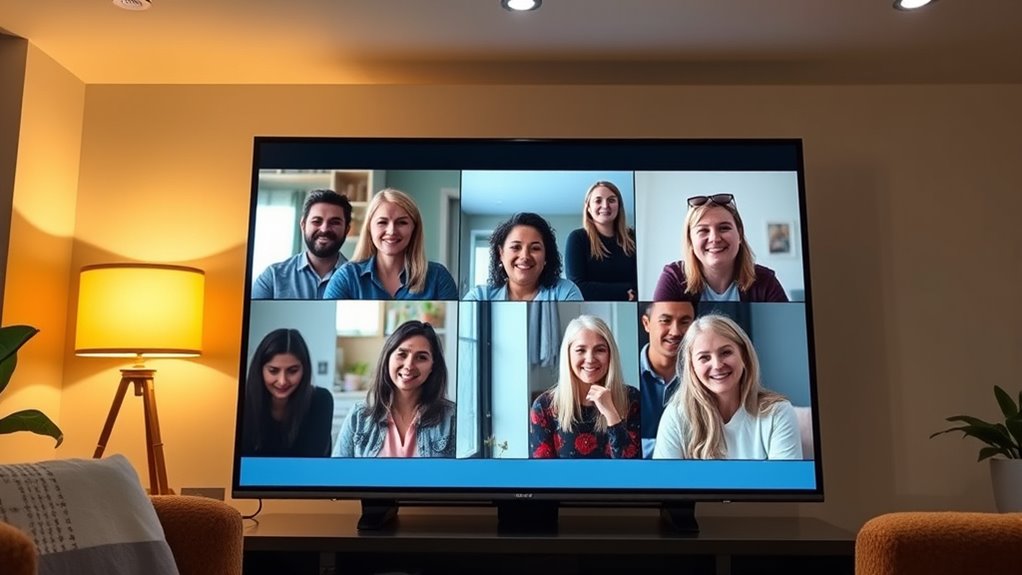
Proper lighting is essential for ensuring deaf participants can clearly see sign language and facial expressions during video calls. Good lighting eliminates shadows and highlights your face, making communication smoother. To achieve this, position your camera so your face is well-lit and avoid backlighting that creates silhouettes. Adjust your lighting source to face you directly rather than from behind. Use this table to understand the impact of lighting and camera positioning:
| Lighting Condition | Camera Positioning | Effect |
|---|---|---|
| Bright, even light | Eye level | Clear, natural visibility |
| Backlit | Above or below face | Shadows obscure expressions |
| Dim lighting | Poor placement | Details lost, hard to read |
Prioritize proper lighting for better visibility and more effective communication. Additionally, understanding lighting techniques can further enhance your video call setup for optimal clarity.
Maintain Good Camera Position and Framing

Good lighting alone isn’t enough; your camera’s position and framing also play a vital role in effective communication. Proper camera positioning ensures your face is clearly visible, making it easier for deaf participants to read your lips or interpret visual cues. Keep the camera at eye level to create a natural and engaging perspective. Use framing techniques to center your face, avoiding excessive headroom or background distractions. Make certain your face occupies most of the frame, with good head and shoulder visibility. Avoid zooming in or out excessively, which can make it difficult to maintain eye contact or interpret gestures. Clear framing helps everyone stay focused and supports better understanding during the call. By paying attention to camera positioning and framing techniques, you promote inclusivity and effective communication.
Speak Clearly and at a Moderate Pace
Speaking clearly and at a moderate pace is essential for ensuring that deaf participants can follow along easily. When you focus on verbal clarity, your words become easier to understand, reducing confusion. Keep your speech pace steady—neither too fast nor too slow—so everyone has time to process what you’re saying. Avoid rushing through your sentences, as rapid speech can make it difficult to catch important details. Remember, clear enunciation and consistent tempo help participants rely less on guesswork or extra cues. By maintaining a steady speech pace and emphasizing clarity, you create a more inclusive environment. Your careful communication supports deaf participants in engaging fully and comfortably in the conversation. Additionally, understanding anime movies and their storytelling styles can serve as a useful reference for clear and expressive communication.
Incorporate Visual Cues and Gestures
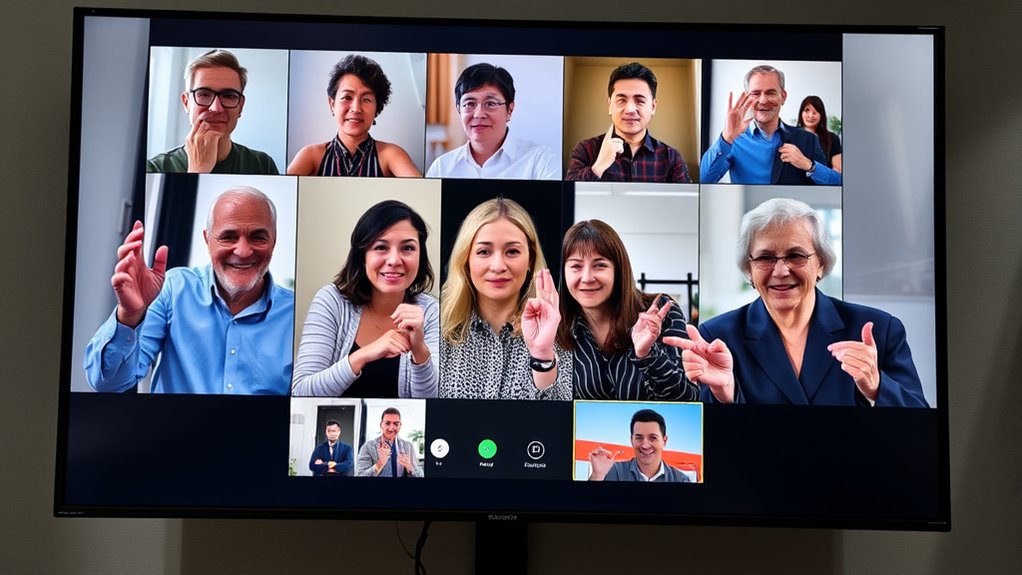
Incorporating visual cues and gestures can considerably enhance understanding for deaf participants during group video calls. Using clear sign language gestures helps convey messages efficiently and reduces misunderstandings. Be mindful of visual signal consistency; consistently using the same gestures for specific concepts prevents confusion. You can also use visual signals like pointing, facial expressions, or body language to emphasize key points. Ensuring your gestures are deliberate and visible on camera makes communication smoother. Remember, visual cues complement spoken language and support those who rely on sign language or visual information. By intentionally integrating these cues, you create an inclusive environment that respects deaf participants’ communication needs and fosters clearer, more effective interactions. Incorporating visual storytelling techniques can further improve engagement and understanding in communication.
Be Patient and Allow for Extra Response Time

During group video calls, it’s important to be patient and give deaf participants extra time to respond. Speak clearly, use visual cues, and stay mindful of delays that might impact communication. This patience helps ensure everyone is included and understands the conversation. Incorporating effective communication strategies can further improve the experience for all participants.
Speak Clearly and Clearly
Since deaf participants rely on visual cues to understand speech, it’s essential to speak clearly and at a steady pace. This helps them follow conversations more easily, especially when artificial intelligence tools assist with real-time captions. To improve communication, consider these tips:
- Enunciate each word clearly, avoiding mumbling or rushing, even with virtual backgrounds that can distract.
- Pause briefly between sentences, giving deaf participants extra response time to process information.
- Avoid speaking too quickly, allowing captions or sign language interpreters to keep up.
- Use visual cues and gestures to support your speech, making it easier for everyone to follow along. Clear speech promotes understanding and ensures all participants stay engaged.
- Incorporating AI-driven captioning can further enhance clarity, providing more accurate and timely transcriptions to support deaf and hard-of-hearing participants.
Use Visual Cues
Using visual cues during a group video call helps deaf participants stay engaged and understand the conversation more effectively. Facial expressions and visual signaling provide context and clarity, making communication smoother. Be patient and allow extra response time, as delays are common. Encourage others to use clear visual cues, such as nodding or hand gestures, to emphasize points. This fosters a more inclusive environment. To illustrate, consider this table:
| Visual Signaling | Facial Expressions | Response Time |
|---|---|---|
| Hand gestures | Smiles and frowns | Allow pauses |
| Nods | Raised eyebrows | Be patient |
| Pointing | Eye contact | Wait for responses |
Additionally, incorporating diverse designs in visual cues can help accommodate different communication styles and preferences, further enhancing inclusivity.
Be Mindful of Delays
While delays are common in group video calls, being patient and allowing extra response time is essential for inclusive communication. Audio lag and connection delays can cause misunderstandings or interruptions, especially for deaf participants relying on visual cues. To be mindful of these delays: 1. Wait a few seconds before responding to give others time to finish speaking. 2. Avoid interrupting when there’s a connection delay or audio lag. 3. Use visual cues to signal when you want to speak or have finished. 4. Be patient if responses are delayed, understanding technical issues happen. Additionally, fostering an understanding of technology integration can help manage expectations and improve overall communication.
Use Captioning and Transcription Features

Make sure to enable real-time captions during the call so deaf participants can follow along easily. Share transcripts promptly after the meeting to guarantee everyone has access to the information. These features help create an inclusive environment where all voices are heard. Additionally, ensuring proper air quality in the workspace can improve concentration and comfort for all participants.
Enable Real-Time Captions
Have you considered enabling real-time captions during your group video calls? Using deaf-friendly technology like real-time captions enhances accessibility and guarantees everyone stays engaged. Here are four ways to make the most of this feature:
- Activate automatic captioning at the start of the call.
- Choose platforms that support accurate transcription services.
- Encourage participants to speak clearly for better captioning quality.
- Regularly check and update caption settings for peak performance.
- Explore automation technologies that can improve efficiency metrics and streamline communication.
Real-time captions bridge communication gaps, making your calls more inclusive. They benefit deaf and hard-of-hearing participants and support those in noisy environments. By leveraging this technology, you create a more respectful and accessible space for all. Remember, enabling real-time captions is a simple step toward fostering an inclusive virtual environment.
Share Transcripts Promptly
Sharing transcripts promptly after a group video call guarantees everyone stays on the same page and can review important details at their convenience. Accurate transcripts ensure clarity and support deaf participants effectively. When you share transcripts quickly, you emphasize transcript accuracy, reducing misunderstandings. To visualize, consider this table:
| Before Sharing | After Sharing |
|---|---|
| Missed details | Clear, accessible info |
| Confusion from errors | Confident review |
| Delayed access | Immediate review |
| Overlooked points | Confirmed understanding |
Prompt sharing helps everyone stay aligned and promotes inclusivity. Use captioning and transcription features to guarantee transcripts are accurate and available right after the call, supporting all participants effectively.
Respect Sign Language Interpreters and Their Space
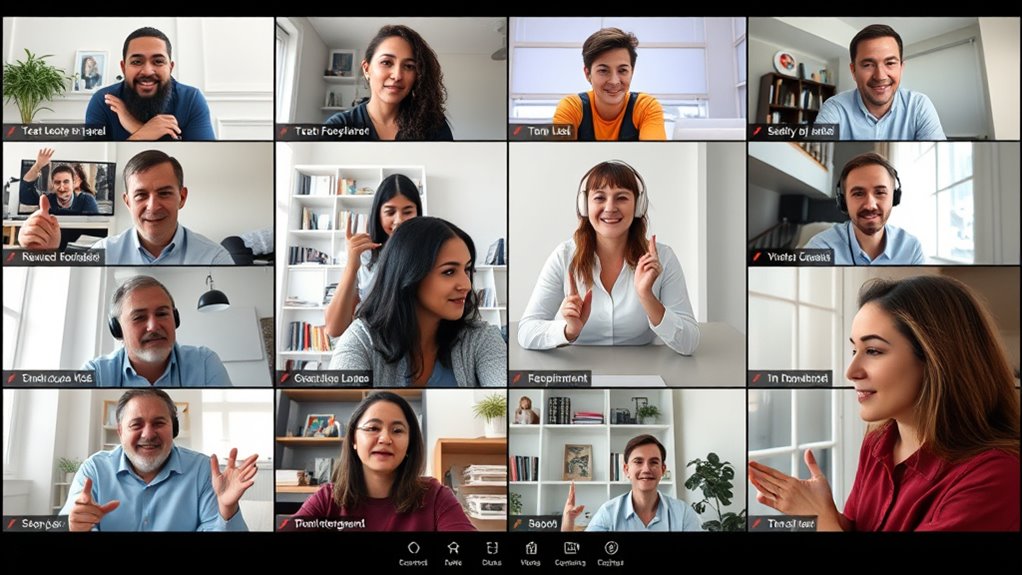
When participating in group video calls, it’s important to recognize that sign language interpreters need space to work effectively. Respecting their role includes understanding their interpreters’ rights and practicing cultural sensitivity.
Here are four ways to support them:
- Give interpreters enough screen space so their signing is visible without obstruction.
- Avoid speaking over or distracting the interpreter during their translation.
- Acknowledge their presence and role, not just the deaf participants.
- Ensure the environment is quiet and free of background noise that could hinder their work.
Promote Inclusive and Respectful Communication Practices
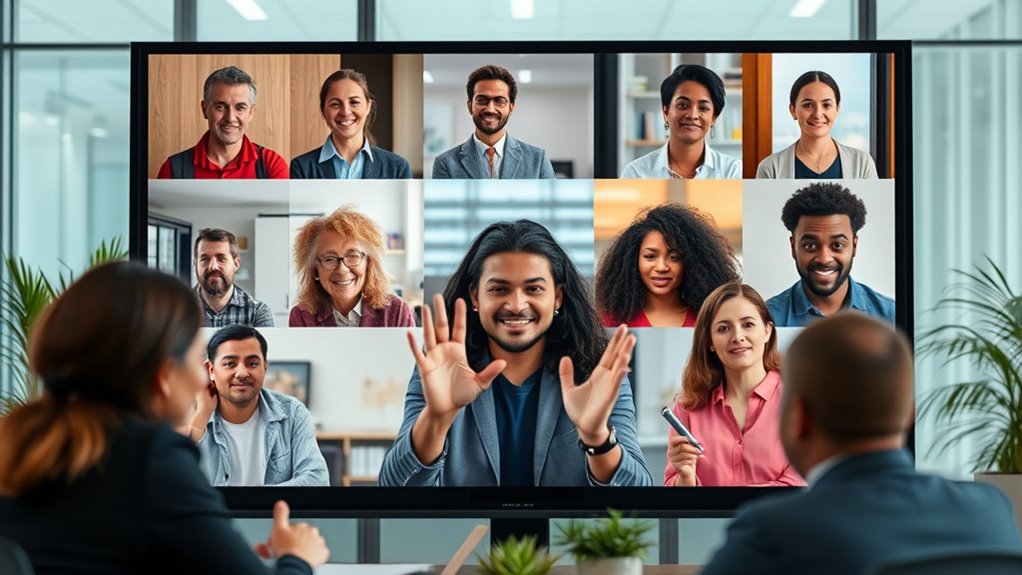
Supporting sign language interpreters involves more than just giving them space; it also means fostering communication environments that are inclusive and respectful for everyone involved. You can promote inclusive language by speaking directly to deaf participants, avoiding slang or idioms that may be confusing, and using clear, straightforward language. Encourage respectful feedback by listening actively and refraining from interrupting, allowing everyone to share their thoughts comfortably. Make sure your communication practices prioritize clarity and patience, ensuring deaf participants feel valued and engaged. By consciously adopting inclusive language and offering respectful feedback, you create a supportive atmosphere that benefits all participants and demonstrates your commitment to accessibility and respect.
Frequently Asked Questions
How Can I Ensure My Background Doesn’T Distract Deaf Participants?
To prevent background distraction and guarantee visual clarity, you should choose a simple, tidy background that doesn’t draw attention away from the speaker. Use a neutral color or a virtual background if needed. Keep your camera at eye level and avoid movement or clutter behind you. This way, deaf participants can focus on your signs or lip movements without unnecessary visual noise, making communication clearer for everyone.
What Are Best Practices for Using Sign Language Interpreters in Group Calls?
When using sign language interpreters in group calls, you should prioritize clear communication by positioning the interpreter where everyone can see them easily, ideally beside the speaker or on camera. Make sure the interpreter’s view isn’t obstructed and speak directly to the group, not just the interpreter. This setup ensures everyone understands the message and supports effective interaction, fostering an inclusive environment for all participants.
How Do I Handle Technical Issues That Affect Visual Access During the Call?
Imagine your call is a bridge connecting hearts and minds. When technical issues strike, focus on restoring clarity—check your internet stability and make sure audio is clear. Use visual cues like chat or raise hands to communicate if audio falters. Keep backups ready, like a second internet connection, to maintain the flow. Your proactive approach keeps the connection strong, ensuring everyone stays engaged and heard, no matter the technical storm.
Are There Specific Platforms Better Suited for Inclusive Communication?
When choosing a platform, consider its accessibility options and platform features. Look for those that offer real-time captioning, sign language interpretation, and adjustable visual settings. Platforms like Zoom and Microsoft Teams are often better suited because they include these features. You can also explore specialized tools designed for inclusivity. By selecting the right platform, you guarantee all participants, especially deaf ones, can communicate effectively and comfortably.
How Can I Encourage Deaf Participants to Feel Comfortable Speaking Up?
To encourage deaf participants to feel comfortable speaking up, focus on building trust and practicing active listening. Show genuine interest in their contributions, maintain eye contact, and give clear cues that their input is valued. Avoid interrupting and guarantee your body language is open. By creating a respectful environment and actively listening, you help deaf participants feel more confident and willing to share their perspectives during the call.
Conclusion
By embracing these etiquette tips, you pave the way for truly inclusive conversations. Remember, every gesture and word acts as a bridge, uniting diverse communication styles like threads in a tapestry. When you prioritize clarity, patience, and respect, you create an environment where deaf participants feel valued and understood. So, let’s be the change—turning simple actions into powerful symbols of inclusion, making every group call a space of connection and understanding that resonates beyond words.











